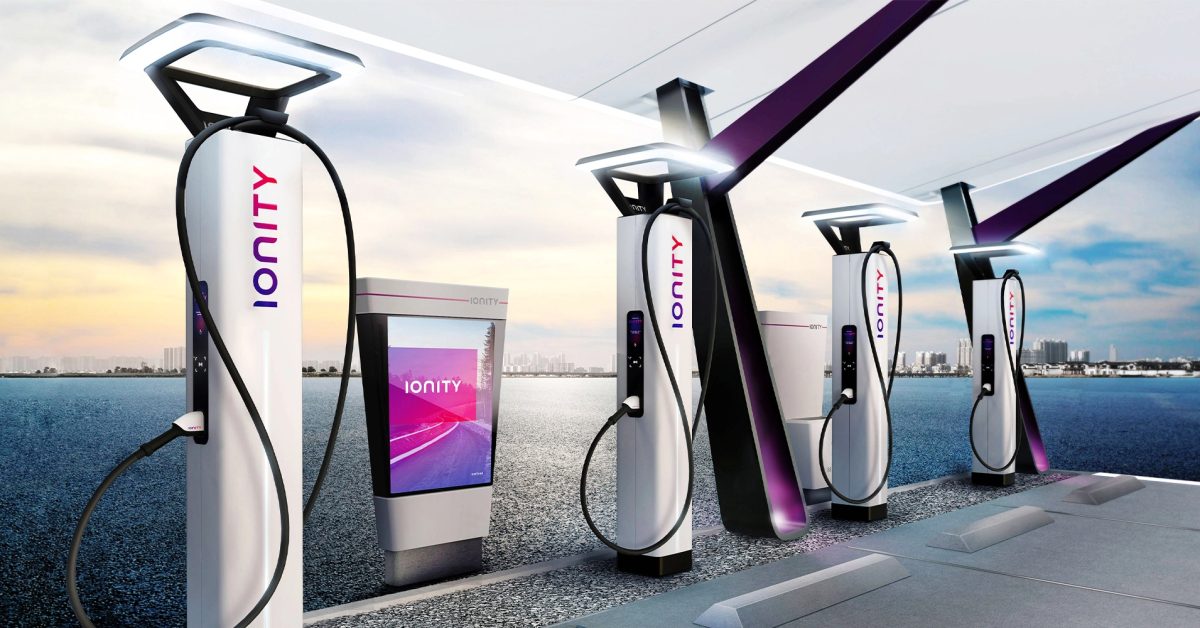
The push to electric vehicles is going on all around the world. Along with the push to get automotive manufacturers to produce electric vehicles is a push to get significant charging networks rolled out all across Europe. One of the largest EV charging networks in Europe belongs to Ionity. Recently it announced a combined €700 million investment from shareholders, including BMW Group, Ford Motor Company, Hyundai Motor Group, Kia, Mercedes-Benz AG, and the Volkswagen Group including Audi and Porsche.
Currently, the Ionity charging network (PDF) is available in 24 countries across Europe. The massive investment will help significantly increase the number of 350kW electric vehicle chargers around Europe by a factor of four. Ionity says that with the new investment, the number of 350kW charging stations will increase to 7000 by 2025. The company plans to install the new high-power charging stations along motorways, in major cities, and along busy trunk roads.
Rather than building single chargers here and there, Ionity says its future locations will be built with an average of 6 to 12 charging points. The company also plans to use the investment to improve the number of chargers at existing sites to help meet demand. Adding additional chargers and more charging points at existing locations will help Ionity meet what it believes will be an increased demand for electric charging in the future.
EU legislation aims to replace most cars that run on fossil fuels with electric vehicles over the next decade. Currently, Ionity operates over 1500 charging locations across 24 countries in Europe. Along with the existing backers, the €700 million investment also adds a new partner with BlackRock bringing its Global Renewable Power platform to the Ionity network. The goal for the charging network is to operate on 100 percent renewable energy. BlackRock currently has 300 renewable electricity projects worldwide utilizing offshore wind, onshore wind, and solar panels.
The complete €700 million investment will occur by 2025. It will allow the addition of between 400 to 1,000 locations along high-traffic corridors in Europe. Ultimately, the number of charging locations will increase by a factor of four from the current number of 1500 to 7000 charging points. The company notes that the expansion of its existing locations will depend on demand at the locations.
Ionity will also use the investment to create something it calls the “Oasis” concept charging locations. These locations will include charging points for electric vehicles near cafés, restaurants, and shopping. Giving electric vehicle owners something to do during the charging process is critical to satisfaction. How much power the Chargers can transfer to the vehicle battery packs controls how long the vehicle has to remain parked, and owners have to wait.
Currently, Tesla has some of the most popular electric vehicles. Its 150kW supercharger stations can charge a Model S with 85 kWh battery packs to 100 percent in 75 minutes. By more than doubling the power the charging stations can deliver, the battery packs will charge significantly faster. Tesla did announce this summer it was working on a Supercharger V3 update that would push charging capacity to 350kW. Multiple automakers are working on allowing their EVs to charge at that much higher rate. One example is Porsche, which has promised to increase the Taycan’s charging rate from 270kW to 350kW soon. It’s worth noting that not all existing EVs will be able to charge at 350kW.
Other than simply shortening wait times for owners of an electric vehicle, the other significant upside of faster charging is less wait at crowded charging stations for everyone. When it comes to an electric vehicle, one of the biggest considerations for most buyers is driving range. With the size of the battery packs limited by space constraints and weight concerns, there is a limit to how many battery cells can be packed inside a vehicle. However, if the batteries can charge very quickly, driving range becomes less of an issue, making gains in charging speed critical for electric vehicle makers.
Ford knows that charging speed is critical, and earlier this month, it announced that it was backing a new EV charging cable to quadrupling charge speed. The challenge is that as more electricity is pumped through the charging cable, the hotter the cable gets. Ford’s cable uses liquid-to-vapor cooling. However, the automaker was clear the charging cable is only functional in the lab right now.
The Ionity charging network was formed in 2017 by BMW, Ford, Daimler, and VW. Ford announced the network was a major partner for its charging network for the Mach-E in October 2020. Petroleum company Shell also put an agreement in place with Ionity back in 2017 for the rollout of ultra-fast chargers in Europe.





